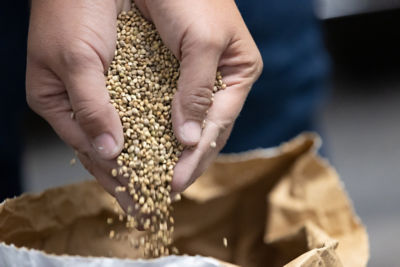Click here to download a PDF version of this spotlight.
» Tomato curly top is an important disease of tomato in arid and semi-arid regions of western North America.
» Tomato curly top is caused by the Beet curly top virus, which has a wide host range.
» Managing tomato curly top relies predominantly on cultural practices.
THE DISEASE
The disease tomato curly top is caused by the Beet curly top virus (BCTV). This virus has a wide host range, infecting over 300 species of plants including beans, pepper, pumpkin, spinach, squash, sugar beet, tomato, watermelon, ornamentals, and many weed species.1,2,3 The disease occurs most commonly in the arid and semi-arid regions of North America and the eastern Mediterranean. In the U. S. the virus is economically damaging in California, Idaho, Utah, and Washington. It can also be a problem in Mexico.
The disease can be more of a problem on fresh market tomatoes than on processing tomatoes because of more open spacing used with fresh market production.3 However, epidemics of BCTV on processing tomatoes in California in 2002 and 2013 impacted hundreds of acres and resulted in millions of dollars in lost production.4
SYMPTOMS
Symptoms of tomato curly top usually begin to appear about 14 days after plants are infected, but symptoms can appear in only a few days during periods of high temperatures and take as long as 30 days to develop when conditions are cool.5 Infected plants become erect (branches more upright) and stunted with distorted growth (Figure 1). Leaves become thick and leathery with up-curled edges and twisted petioles. Branches may bend downward. Leaves develop a light-green to yellow coloring, and the veins on the underside of the leaves become purple.1,2,3,5
 Figure 1. Stunting and discoloration symptoms of tomato curly top.
Figure 1. Stunting and discoloration symptoms of tomato curly top.
If plants are infected when young, they can quickly die. All of the fruit on the plant may turn red prematurely, regardless of age, and immature fruit become dull and wrinkled (Figure 2). However, with late infections, normal and symptomatic fruit can occur together.1,2,3 Disease severity is highest with high light intensity, prolonged heat, and high evaporation rates. Severity is usually lower when humidity levels are above 50% and high at humidity levels below 35%.5
 Figure 2. Fruit ripen prematurely on tomato plants infected with the Beet curly top virus.
Figure 2. Fruit ripen prematurely on tomato plants infected with the Beet curly top virus.
DISEASE SPREAD
BCTV is spread from plant to plant by the beet leafhopper (Circulifer tenellus) [Figure 3]. The virus is not seedborne and is not mechanically transmitted.1,2 The leafhoppers feed in the phloem (food conducting) tissues of the tomato plant where they pick up and deposit the virus. BCTV infects and replicates in the phloem cells. The beet leafhopper can acquire the virus after only a few minutes of feeding, but higher numbers of virus particles are acquired with extended feedings, up to 48 hours. Once the insect has acquired BCTV, it can remain infective for the rest of its life, but it will not pass the virus on to its offspring. Only a few minutes of feeding are needed to transmit the virus to a healthy plant.1,3
 Figure 3. Beet leafhoppers vector the Beet curly top virus and infect tomato plants when they feed. Imad Eujayl, USDA-ARS.
Figure 3. Beet leafhoppers vector the Beet curly top virus and infect tomato plants when they feed. Imad Eujayl, USDA-ARS.
Tomatoes are not a preferred host for the beet leafhopper. Leafhoppers will land on tomato plants and feed for a short amount of time before moving on to another plant. On preferred hosts, such as sugar beets, Russian thistle, and wild mustard, the insects will feed for long periods of time. Because the leafhoppers feed only transiently on tomatoes, there is generally no tomato-to-tomato spread of BCTV. Therefore, the disease appears in tomato fields in random, scattered distributions, based on the patterns of beet leafhopper feeding. The beet leafhopper prefers to feed on plants near areas of bare soil, so infections tend to be more frequent on field margins.1,2
Many of the preferred hosts of the beet leafhopper (members of the beet family and several weed species) are also hosts of BCTV, and these plants serve as reservoirs of infection. In California, infections on tomato usually start in the spring, when the weed hosts begin to dry up, causing the leafhoppers to move to other plants.3
MANAGEMENT
None of the current commercially available tomato varieties have high levels of resistance to BCTV. Management strategies for tomato curly top focus on cultural practices. Growers should avoid planting tomatoes near sugar beet fields or near range-lands containing weed hosts that can serve as reservoirs of the virus.3 Managing weed hosts in and around the tomato field can help reduce the incidence of the disease in the tomato crop.
Applying insecticides to the tomato crop to control the beet leafhopper vector is not effective for managing the diseases because the leafhopper transmits the virus so quickly and because there is no tomato-to-tomato transmission of the virus. In some areas of California, there have been regional efforts to treat large acreages of range-land near tomato and sugar beet plantings to control the insect vector before it reaches the crop, and those efforts have been partially successful. Row covers are effective at providing physical barriers to keep leafhoppers from feeding on tomato plants and transmitting BCTV. The covers should be removed when the tomato plants start to flower to allow adequate rates of pollination.5,6
With processing tomatoes, disease incidence can be reduced by increasing planting density, for example by planting double rows. The higher density reduces the amount of bare ground, which attracts beet leafhoppers. The higher planting density also spreads out the infection among a larger number of plants, thus lowering the overall level of disease incidence (number of plants infected divided by the total number of plants).1 However, this is not a good strategy to use with fresh market tomatoes because increasing planting density can alter the size and quality of the fruit.6
SOURCES
1 Davis, R., Miyao, G., Subbaro, K., Stapelton, J., and Aegerter, B. 2013. Tomato curly top. How to Manage Pests: UC Pest Management Guideline.
http://ipm.ucanr.edu/PMG/r783102011.html.
2 Koike, S. and Gilbertson, R. 2010. Curly top disease occurring in coastal tomato and pepper. Salinas Valley agriculture. UCANR. August 24, 2010.
3 Zitter, T. and Wintermantel, W. 2014. Beet curly top virus. In Compendium of Tomato Diseases and Pests, Second Edition. The American Phytopathological Society, St. Paul, MN.
4 Chen, L. and Gilberston, R. 2016. Transmission of Curtoviruses (Beet curly top virus) by the Beet Leafhopper (Circulifer tenellus). In J. K. Brown (ed.) Vector-Mediated Transmission of Plant Pathogens. The American Phytopathological Society. St. Paul.
5 Curly top virus. Texas Plant Disease Handbook. Texas A&M Extension.
6 Heflebower, R. and Schalau, J. 2014. Controlling curly top virus of tomato. Utah State University Extension. Horticulture/PlantProblems/2014-01pr.
Websites verified 10-02-2019
ADDITIONAL INFORMATION
For additional agronomic information, please contact your local seed
representative.
Performance may vary from location to location and from year to year, as local growing, soil and weather conditions may vary. Growers should evaluate data from multiple locations and years whenever possible and should consider the impacts of these conditions on the grower’s fields. The recommendations in this article are based upon information obtained from the cited sources and should be used as a quick reference for information about tomato diseases. The content of this article should not be substituted for the professional opinion of a producer, grower, agronomist, pathologist and similar professional dealing with this specific crop.
BAYER GROUP DOES NOT WARRANT THE ACCURACY OF ANY INFORMATION OR TECHNICAL ADVICE PROVIDED HEREIN AND DISCLAIMS ALL LIABILITY FOR ANY CLAIM INVOLVING SUCH INFORMATION OR ADVICE.
9068_S4 Published 10-11-2019
Seminis® is a registered trademark of Bayer Group. All other trademarks are property of their respective owners. © 2019 Bayer Group. All rights reserved.




